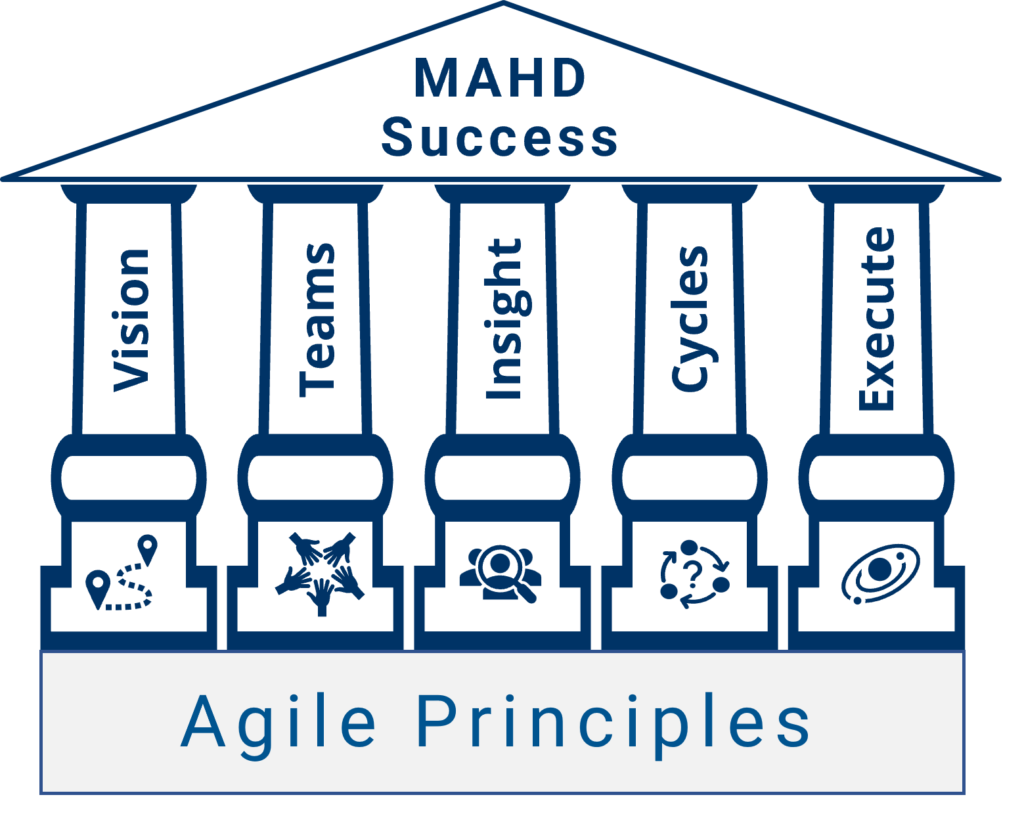The MAHD Framework is an agile-based product development process designed for flexibility and scalability, managing everything from simple projects to complex systems and the entire product lifecycle. It integrates seamlessly with systems like Stage-Gate, SAFe, and Six Sigma while supporting portfolios, innovation pipelines, and sustaining engineering. Rooted in agile principles, MAHD incorporates key elements tailored for hardware development.
Teams that attempt to apply agile methodologies like Scrum directly to hardware development often become frustrated. This is because hardware features cannot be easily expressed as user stories, lead times require looking forward, and products must be completed on a known schedule. However, the principles of agile are sound and provide a foundation to deliver higher value solutions, faster.
The MAHD Framework was designed specifically to adhere to agile principles but modify the tactics to manage the unique, and often more constrained, characteristics of hardware development. MAHD methods incorporate the needs of physical products to:
Align sub-components and disciplines such as electrical, mechanical, and software
Allow flexibility to adapt to changes, while identifying attributes that need to freeze
Develop prototyping and validation strategies that work for hardware
Incorporate support functions such as procurement as well as external partners
Manage risk while maturing the design, documentation, and quality plans
Visit our FAQ to address specific questions you may have or learn more about the benefits you should expect.
The idea for an agile approach tailored to hardware development began in 2014 with Dorian Simpson, who developed the original MAHD Framework. Through collaboration and trials with product leaders across various companies, the methods were refined until MAHD Framework 1.0 was officially launching in 2017.
Shortly after, MAHD Framework LLC was established to advance product development through agile methods, offering training, consulting, and coaching to help companies adopt and implement more effective approaches to creating new products.
Beyond relying on agile principles and being purpose-built for hardware, some of the principles guiding the MAHD Framework development include:
It must be practical and straightforward for teams to learn and apply… quickly,
The MAHD team continuously works to improve and refine the framework to be more valuable, easier to use and faster to learn with MAHD 4.0 being released soon.
The focus of the Core MAHD Framework is to manage projects from concept to launch while adhering to Agile principles.
The Complete MAHD Framework applies agile methods to an organization’s entire product development process.
Since its launch in 2017, the MAHD Framework has evolved based on real world learning with companies implementing the framework. Each release enhances the key concepts and adds new learning and implementation tools.
MAHD 4.0 is currently planned for release in 2025 with new tools and enhancements to make it easier to learn and faster to implement.
Agile principles can be applied to any project or process. However, specific tactics like Scrum and SAFe were designed for pure software-based products. The MAHD Framework is optimized for solutions that have physical components such as mechanical and electrical components but almost always include embedded firmware as well as software elements.
The MAHD Framework provides agile methods and tools built on five key pillars that are proven to deliver product development success.

The agile manifesto identifies 12 principles that were written with SW in mind. Most are valid for HW, but specific implementation methods must be reconsidered for physical products. See our article on MAHD’s refinement of these 12 agile principles for HW.
The first pillar of the MAHD Framework focuses on the ability to consider the needs of the entire project, which is critical to hardware development. This includes strategic priorities as well as constraints such as cost, schedule, and resources.
The MAHD Framework includes the principle that teams should be empowered to make decisions and be held accountable for the results. Teams should also be responsible for self-correction and communication.
The third pillar is the principle that only when customers see and experience your solution can they provide meaningful input. This principle is critical to the success of hardware projects.

The MAHD Framework uses short execution and learning cycles to allow teams to focus on the most important and valuable project elements. This approach also allows teams to adapt to changing requirements and project needs.

The fifth pillar, execution excellence, is about giving teams the tools and methods to focus, meet commitments, collaborate, and consistently deliver their best work in the most efficient way possible.
The table below summarizes the differences between the MAHD Framework and other common Agile-based processes. The primary difference is that while MAHD builds on Agile principles, the tactics are designed specifically to meet the needs of physical products. Download the whitepaper for a more comprehensive comparison.
Learn how MAHD, SAFe and other scaled Agile approaches compare and which is best for your situation.
To discover how the MAHD Framework can accelerate your NPD efforts, download the Intro to MAHD e-book or contact us to discuss your needs.
Download the comprehensive Introduction to MAHD E-book to learn about the key elements of the MAHD Framework.
Request a 45-minute overview and discussion of your situation. We can provide an overview of the MAHD Framework and help you determine if MAHD is a good fit for your goals.
Going MAHD Newsletter
Get the latest articles and resources delivered directly to your email.
© 2023 MAHD Framework, LLC